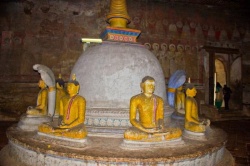Difference between revisions of "Aluvihara Cave Temple"
| Line 10: | Line 10: | ||
Some of the surviving [[monks]] then decided to commit the whole of the [[Tipitaka]] to [[writing]]. | Some of the surviving [[monks]] then decided to commit the whole of the [[Tipitaka]] to [[writing]]. | ||
| − | The | + | The [[Fourth Buddhist Council]] was convened and as a result, it was written down for the first time in the island’s history. |
In this way, the teachings were preserved in its original [[form]] and [[Buddhism]] survived this difficult period. | In this way, the teachings were preserved in its original [[form]] and [[Buddhism]] survived this difficult period. | ||
Latest revision as of 16:28, 1 February 2016
Just 32 kilometers north of Kandy is a small cave temple highly significant to the history Buddhism.
During the 1st century BCE, the island was ravaged by anarchy and starvation, and the very survival of Buddhism was threatened.
This was because at that time, its teachings were orally transmitted by monks, and many had died or left the island.
Some of the surviving monks then decided to commit the whole of the Tipitaka to writing.
The Fourth Buddhist Council was convened and as a result, it was written down for the first time in the island’s history.
In this way, the teachings were preserved in its original form and Buddhism survived this difficult period.
The momentous event was held at the Aluvihara Cave Temple, originally known as the Aloka Lena, or “Cave of Light”.
